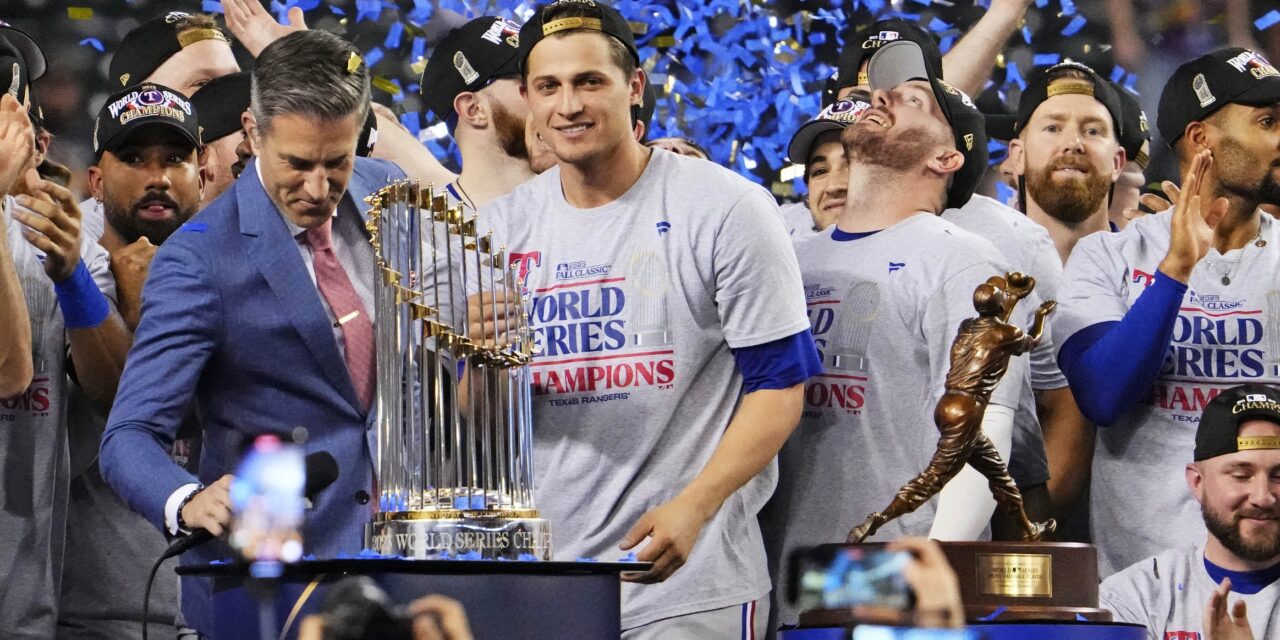On Wednesday night, the Texas Rangers exercised their demons and won their first World Series title in franchise history over the Arizona Diamondbacks. It was a tumultuous road back to glory for the Rangers, who appeared in back-to-back Fall Classics in 2010 and 2011 and enjoyed a run of success in the mid-2010s before ultimately undergoing a lengthy rebuild process that kept them out of the postseason until this year.
In recent years, Texas’s core was largely compiled via the free agent market, but those big-money acquisitions are far from the only reason this team reached the promise land. Chris Young and the rest of the Rangers’ front office put a premium on player development while also identifying under-the-radar talent on the open market and accurately assessing the trade market, which culminated in a title and may also be a blueprint for the New York Mets as they enter a new era under David Stearns.

Before the lockout officially commenced during the 2021-22 offseason, the Mets and Rangers were among the most aggressive teams in terms of signing free agents. Both organizations were willing to go above and beyond financially in hopes of improving their teams following disappointing campaigns, but they went about doing so in slightly different fashions. New York spread around the wealth on the position player side and opted not to splurge on a star, instead making a splash move for a pitcher in Max Scherzer.
Texas, on the other hand, shelled out $175 million over seven years for Marcus Semien before luring Corey Seager on a 10-year, $325 million deal that locked up two of the league’s best middle infielders and established arguably the best double-play duo in the league for the better part of a decade. Both players have lived up to the hype thus far as Semien hit .276/.348/.478 with a 124 wRC+ and 6.7 fWAR this season, while Seager slashed .327/.390/.623 with a 169 wRC+ and 6.1 fWAR on his way to becoming an All-Star starter along Semien as well as the World Series MVP.
That same offseason, Texas signed Jon Gray to a four-year, $56 million contract that marked the first substantial move during the team’s retooling of its rotation. Gray, despite throwing just 5 2/3 innings in the playoffs due to injury, has been a stabilizing presence for the Rangers with a 4.05 ERA and 3.7 fWAR across 53 starts in his two seasons with the club. The 2022-23 offseason was where a lot of the dirty work was done, however, as the Rangers signed three starters to multi-year deals that they foresaw as key pieces. Jacob deGrom was the first domino to fall as he agreed to a five-year, $185 million deal and looked like his usual self through six starts to open the year before undergoing Tommy John surgery in June, but it was a worthy gamble that could still pay off.
Shortly after deGrom, Andrew Heaney signed a two-year, $25 million deal with the team after a breakout 2022 season and pitched to a 4.15 ERA with a 1.3 fWAR across 34 games and 28 starts while also appearing in five postseason games with a 4.09 ERA. Their most momentous acquisition, however, came when they brought in Nathan Eovaldi on a two-year, $34 million deal. Eovaldi started 25 games this season and put up a 3.63 ERA and 2.5 fWAR en route to earning All-Star honors while also reprising his role as “Big Game Nate” with a 2.95 ERA across six starts this postseason.
Additionally, the Rangers’ staff greatly benefitted from reinforcements acquired at the trade deadline. Jordan Montgomery, who came over from St. Louis, stepped in and emerged as perhaps the team’s best starter down the stretch with a 2.79 ERA in 11 starts before posting a 2.90 ERA in the playoffs. Scherzer, despite several injuries and a poor showing in the postseason, helped Texas sneak into the playoffs in a tight race with a 3.20 ERA in eight starts during the regular season.
The development and subsequent importance of players such as Dane Dunning, who was acquired in the Lance Lynn trade, and Josh Sborz, who the Rangers received from the Dodgers in a low-profile move in 2021, can’t be overlooked as well. Sure, the Rangers have spent an exorbitant amount of money on pitching, but they have also spent it in the right places while supplementing that talent in other areas. For example, Will Smith signed a one-year, $1.5 million deal in the middle of spring training and enjoyed a solid season as the team’s primary closer, while 2019 sixth-round pick Cody Bradford seemingly came out of nowhere to post a 1.17 ERA in five postseason appearances.

Mark J. Rebilas-USA TODAY Sports
Outside of Seager and Semien, the Rangers’ offense is largely comprised of homegrown talent or players who were undervalued before coming to Texas and developing into key contributors. There’s no better example than Adolis García, who was acquired from the St. Louis Cardinals for cash considerations after the 2019 season and was even DFA’d by the Rangers in 2021 before returning to the organization and becoming a star while slashing .323/.382/.726 with eight home runs this postseason. Jonah Heim is in the same vein as he came over via trade from the division rival Oakland A’s before the 2021 season and quickly blossomed into one of the game’s best two-way catchers.
The development of former top picks such as Evan Carter and Josh Jung can’t be overlooked either. Carter, who turned 21 in August, was a second-round pick by the Rangers in 2020, who were widely questioned for the selection at the time of the draft. The outside noise proved to be irrelevant, however, as Carter rocketed up prospect lists and was one of baseball’s best hitters after his call-up late in the regular season, in addition to slashing .300/.417/.500 in the playoffs. Jung, who was Texas’ first-round pick in 2019, was the team’s top prospect upon first being brought up to the majors in 2022 and was an All-Star starter as a rookie this season.
The Texas Rangers constructed a roster that accumulated talent in various ways and looks set to be a perennial contender for years to come. There’s a lesson to be learned here for the Mets, as the Rangers also have an owner who is willing to go to great lengths financially to ensure the success of the organization. There are other factors, of course, as Texas has made smart investments on the free agent market and consistently come away with plus value in trades while also developing an eye on under-the-radar talent and potential. The formula for Stearns and the rest of the front office is right in front of them, and now they have to execute.
















